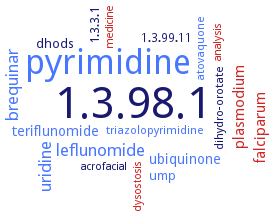1.3.98.1: dihydroorotate dehydrogenase (fumarate)
This is an abbreviated version!
For detailed information about dihydroorotate dehydrogenase (fumarate), go to the full flat file.

Word Map on EC 1.3.98.1 
-
1.3.98.1
-
pyrimidine
-
leflunomide
-
brequinar
-
uridine
-
plasmodium
-
falciparum
-
ubiquinone
-
teriflunomide
-
dhods
-
1.3.3.1
-
ump
-
dihydro-orotate
-
triazolopyrimidine
-
atovaquone
-
1.3.99.11
-
dysostosis
-
analysis
-
medicine
-
acrofacial
- 1.3.98.1
- pyrimidine
- leflunomide
- brequinar
- uridine
- plasmodium
- falciparum
- ubiquinone
- teriflunomide
-
dhods
-
1.3.3.1
- ump
-
dihydro-orotate
- triazolopyrimidine
- atovaquone
-
1.3.99.11
- dysostosis
- analysis
- medicine
-
acrofacial
Reaction
Synonyms
(DHO) dehydrogenase, 4,5-L-dihydroorotate:oxygen oxidoreductase, ACT/DHOD, class 1A DHOD, class 1A DHODH, class 1A dihydroorotate dehydrogenase, DHOD, DHOD1, DHOD2, DHOD3, DHODA, DHOdehase, DHODH, DHODH-1A, dihydroorotate dehydrogenase, dihydroorotate dehydrogenase class 1A, Dihydroorotate oxidase, EC 1.3.3.1, LmDHODH, More, oxidase, dihydroorotate, TcDHOD
ECTree
Advanced search results
Crystallization
Crystallization on EC 1.3.98.1 - dihydroorotate dehydrogenase (fumarate)
Please wait a moment until all data is loaded. This message will disappear when all data is loaded.
hanging drop vapor diffusion technique, 30% polyethylene glycol, 0.2 M sodium acetate, 0.1 M Tris-HCl, pH 8.5, monoclinic crystals, space group P21
-
hanging drop vapour diffusion method, with 30% PEG 6000, 1 mM dithiothreitol, 0.2 M sodium acetate, and 0.1 M Tris-HCl at pH 8.5
-
apo-enzyme and in complex with orotate and with fumarate, to 2.0 A, 2.5 A and 1.9 A resolution, respectively. Both orotate and fumarate bind to the same active site and exploit similar interactions, consistent with a ping-pong mechanism. Rearrangements in the conformation of the catalytic loop have direct influence on the dimeric interface
-
by the vapour-diffusion technique using lithium sulfate as the precipitating agent, to better than 2.0 A resolution, crystals belong to space group P61, presence of two molecules in the asymmetric unit
-
crystallized by the vapour-diffusion technique using sitting and hanging drops (lithium sulfate as the precipitating agent). The crystals belong to space group P6(1), with unit-cell parameters a = 143.7, c = 69.8 A. X-ray diffraction data are collected to 2.0 A resolution using an in-house rotating-anode generator
-
to 2.4 A resolution, space group C2221. Class 1A family enzyme, the monomer folds as a alpha/beta barrel consisting of a core of central eight parallel beta-strands surrounded by a ring of eight alpha-helices. The asymmetric unit of the crystal structure contains four monomers that are arranged as two distinct homodimers that are nearly perpendicular to each other, i.e. the tetramer has the shape of the letter L
crystals of the TcDHODorotate complex are grown at 4°C by the sitting-drop vapour-diffusion technique using polyethylene glycol 3350 as a precipitant. The crystals diffract to better than 1.8 A ° resolution using synchrotron radiation (lambda = 0.900 A). X-ray diffraction data are collected at -173°C and processed to 1.9 A ° resolution with 98.2% completeness. The TcDHOD crystals belong to the orthorhombic space group P2(1)2(1)2(1), with unit-cell parameters a = 67.87, b = 71.89, c = 123.27 A
DHODorotate complex by the sitting-drop vapour-diffusion technique using polyethylene glycol 3350 as a precipitant, to better than 1.8 A resolution, crystals belong to the orthorhombic space group P212121, with unit-cell parameters a = 67.87, b = 71.89, c = 123.27 A
in ligand-free form and in complexes with inhibitor oxonate, physiological substrates and products of the first and second half-reactions. Ligands bind to the same active site of enzyme, consistent with one-site ping-pong Bi-Bi mechanism. The binding of ligands does not cause any significant structural changes, and both reduced and oxidized FMN cofactors are in planar conformation. Resiude C130 is well located for abstracting a proton from dihydroorotate C5 and transferring it to outside water molecules. The bound fumarate is in a twisted conformation, which induces partial charge separation. The thermodynamically favorable reduction of fumarate with reduced FMN seems to proceed in the way that its C2 accepts a proton from C130 and C3 a hydride or a hydride equivalent from reduced FMN N5


 results (
results ( results (
results ( top
top





